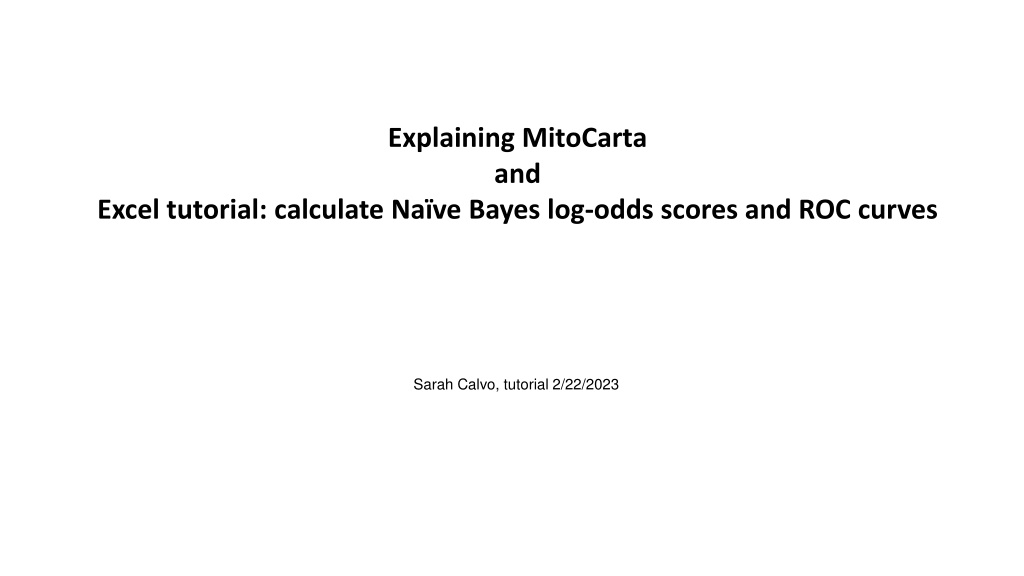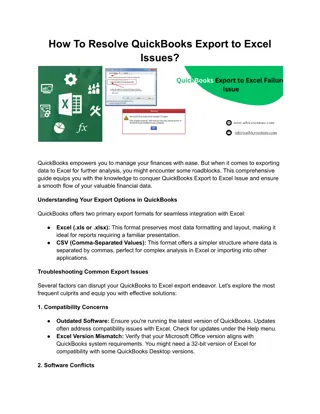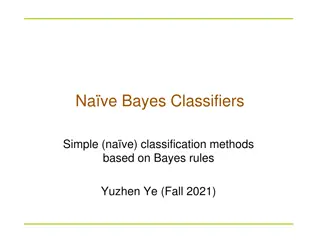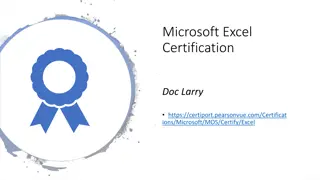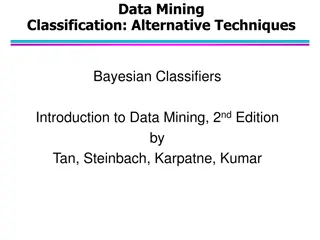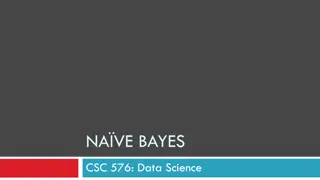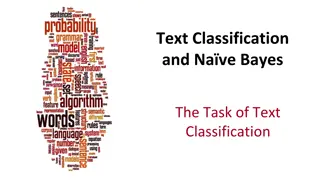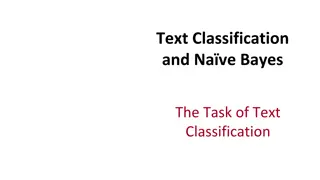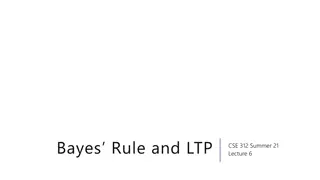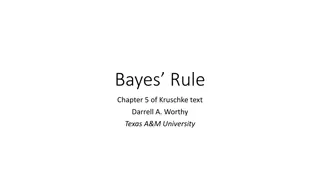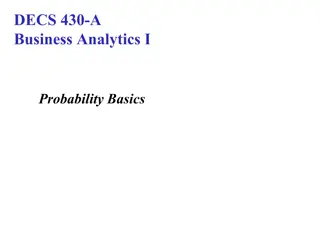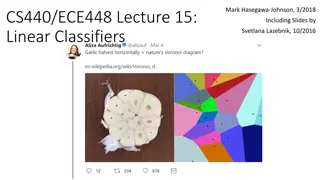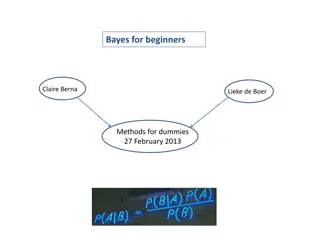Understanding MitoCarta and Naive Bayes Integration in Excel Tutorial
Explore the process of calculating Naive Bayes log-odds scores and ROC curves in Excel using the MitoCarta dataset. Discover the best experimental techniques for isolating mitochondria in Arabidopsis studies, comparing methods like differential centrifugation and affinity purification.
Download Presentation

Please find below an Image/Link to download the presentation.
The content on the website is provided AS IS for your information and personal use only. It may not be sold, licensed, or shared on other websites without obtaining consent from the author. Download presentation by click this link. If you encounter any issues during the download, it is possible that the publisher has removed the file from their server.
E N D
Presentation Transcript
Explaining MitoCarta and Excel tutorial: calculate Na ve Bayes log-odds scores and ROC curves Sarah Calvo, tutorial 2/22/2023
Motivation example: which experimental technique to isolate mitos is best? Many Arabidopsis studies isolate mitochondria and perform proteomics. Which method is best?
Motivation example: which experimental technique to isolate mitos is best? Many Arabidopsis studies isolate mitochondria and perform proteomics. Which method is best? Method: training data of gold+ (known mito proteins) and gold- (non-mito proteins) apply Na ve Bayes log-odds scores generate ROC curve Conclusions: 3 papers with very similar results: ~ 50% sensitivity with ~40% FDR Differential centrifugation +/- affinity purification similar results Affinity purification alone (Kuhnert) is worse
Outline Steps to build human MitoCarta Tutorial in Excel, example 1 Tutorial In Excel, you do on your own
Building Human MitoCarta: catalog of proteins that reside in the mitochondrion Na ve Bayes Integration: principled method to combine datasets by scoring each by its accuracy on training data Pagliarini, Calvo et al, Cell 2008
Nave Bayes integration Step 1: define training data of known mito proteins (gold+) and non-mito proteins (gold-) Step 2: compile features that are datasets that might provide clues into mito localization Step 3: score each feature by its accuracy on gold+ and gold- Step 4: combine scores across features
Nave Bayes integration Step 1: define training data of known mito proteins (gold+) and non-mito proteins (gold-) Step 2: compile features that are datasets that might provide clues into mito localization Step 3: score each feature by its accuracy on gold+ and gold- Step 4: combine scores across features 591 gold+ from literature (excluding proteins determined solely by proteomics) 2519 gold- from literature Pagliarini, Calvo et al, Cell 2008
Nave Bayes integration Step 1: define training data of known mito proteins (gold+) and non-mito proteins (gold-) Step 2: compile features that are datasets that might provide clues into mito localization Step 3: score each feature by its accuracy on gold+ and gold- Step 4: combine scores across features Calvo et al, NAR 2015
Nave Bayes integration Gold+ Step 1: define training data of known mito proteins (gold+) and non-mito proteins (gold-) Step 2: compile features that are datasets that might provide clues into mito localization Step 3: score each feature by its accuracy on gold+ and gold- Step 4: combine scores across features ? score gold + ? score gold LogOdds = log2 = score Calvo et al, NAR 2015
Nave Bayes integration Gold+ Step 1: define training data of known mito proteins (gold+) and non-mito proteins (gold-) Step 2: compile features that are datasets that might provide clues into mito localization Step 3: score each feature by its accuracy on gold+ and gold- Step 4: combine scores across features 7 ? scorek gold + ? scorek gold Na ve Bayes score = log2 ?=1 Example: ECHDC1 Assumes conditional independence across features (ethylmalonyl-CoA decarboxylase 1) EG Given protein is mito, detection by MS/MS is independent of having yeast homolog, independent of having an MTS, etc Calvo et al, NAR 2015
Conditional independence of features gold+ correlations gold- correlations Pagliarini, Calvo et al, Cell 2008
Nave Bayes integration: metrics to assess accuracy Sensitivity vs Precision FDR = fp / (tp+fp) Precision = tp / (tp+fp) MSMS Na ve Bayes Coexpression Domain TargetP Sensitivity tp / (tp+fn) Specificity tn / (tn+fp) Ancestry Induction Yeast Calvo et al, NAR 2015
Nave Bayes integration: metrics to assess accuracy Sensitivity vs Specificity Sensitivity vs Precision Na ve Bayes Na ve Bayes MSMS Domain Coexpression MSMS Domain Coexpression TargetP TargetP Yeast Ancestry Yeast Ancestry Induction Induction MS/MS alone: >50% FDR at 80% Sn Calvo et al, NAR 2015
What is accuracy of APEX data? Matrix data is highly specific but not sensitive APEX-matrix Sensitivity FDR Notes APEX-IMS APEX-matrix 49% 0% 6 FP were mito upon manual inspection APEX-IMS 12% 16% 4 FPs were contaminant APEX-MOM APEX-MOM 9% 34% 8 FPs were not inside mito Na ve Bayes MSMS Domain Coexpression TargetP Yeast Ancestry Induction Assess human APEX data via MitoCarta1.0 training sets (577 gold+, 2412 gold-)
Human MitoCarta versions 1, 2, 3 MitoCarta Version Method Training Data sources # genes MS/MS of 14 tissues + Bayesian integration + GFP validation 591 gold+ 2519 gold- MS/MS, domain, Induction, Co-expr, Yeast, Ancestry, TargetP 1.0 (Cell 2008) 1098 APEX-matrix + Bayesian integration 960 gold+ 17468 gold- MS/MS, domain, Induction, Co-expr, Yeast, Ancestry, TargetP 2.0 (NAR 2015) 1158 Manual annotation of MitoCarta2.0 including pathways + sub-mito loc 3.0 (NAR 2021) NA Literature 1136 >3500 total citations; >10,000 page views per year
Updated features more accurate on human: targetP2.0 and MitoDomain2022 Rerun with updated versions of: targetP2.0, MitoFates1.2, MitoDomain2022 Human MitoCarta2.0 MSMS Na ve Bayes Coexpression Domain2022 Domain TargetP Domain2014 Ancestry targetP2.0 MitoFates Induction Yeast targetP1.0
Use Arabidopsis gold+ and gold- : best conditionally independent features Na ve bayes Conclusions: TargetP2.0 alone is better than bucket biochem MS/MS By combining features, now ~60% sensitivity at 20% FDR Lots of room for improvement!
Protocol for gold+ via manual review in Arabidopsis thaliana 1. Use TAIR & SUBA databases to compile potential mito proteins and associated PubMed IDs Assign possible_mito label if any mito annotation TAIR or SUBA Identify subset with PMID of experimental evidence for manual review Link each gene to all PMIDs associated with GO mito annotation N=4395 possible_mito N=746 genes for manual review N=361 unique PMIDs 2. Assign gold+ if an associated PMID shows mito loc by any of these methods: GFP-tagging/microscopy that co-localizes with mito marker (MitoTracker, AOX-RFP, etc); either full-length or N-terminal region Fractionation & Western (with proper controls) Presence in Co-IP pulldown of mito complex (especially in crystal structure) In vitro import assay Not counted as gold+ evidence: MS/MS functional studies of KO (eg lower complex I upon KO) Yeast complementation Note lower bar if protein is BBH to human/yeast mito gene (eg lack of proper control)
Arabidopsis thaliana gold+: two-thirds have human mito homolog
Extensive dual targeting between chloroplast and mito Note > 54/489 gold+ have good evidence for dual targeting (catalogs of >100 dual targeted proteins, but not all great evidence) Note 13/489 targeted to mito and another location (eg peroxisome, cytosol, etc) The FEBS Journal, Volume: 276, Issue: 5, Pages: 1187-1195, First published: 16 February 2009, DOI: (10.1111/j.1742-4658.2009.06876.x)
Protocol for gold- Assign gold- if evidence of non-mito loc from GO with strong evidence code (excluding gold+ or possible_mito): EXP= Direct experimental evidence IDA= Inferred by direct assay Gold- compartment annotations TAS= traceable author statement IC= Inferred by curator
Use Arabidopsis gold+ and gold- : best conditionally independent features Na ve bayes Conclusions: TargetP2.0 alone is better than bucket biochem MS/MS By combining features, now ~60% sensitivity at 20% FDR Lots of room for improvement!
Gold+ status for all MITO-EPI species Species Gold+ mito Status # Gold+ Human MitoCarta3.0 n/a 1136 Yeast Vogtle, Nat Comm 2017 n/a 986 Species Gold+ mito method Status # Gold+ Trypanosoma Literature curation done 397 Leishmania BBH from Tryp done 352 Acanthamoeba BBH human & yeast mito done 270 Giardia Literature curation need to redo 31 Arabidopsis Literature curation done 489 Plasmodium Literature curation not started Babesia BBH from Plasmodium not started
Gold+ and gold- per MITO-EPI species Gold+: Possible_mito: Gold-: Other: strong evidence mitochondria from literature manual curation any evidence mito in GO (including high throughput papers) strong evidence non-mito in GO (excluding gold+ or possible_mito) all remaining proteins Species Gold+ Gold+ Status Gold- Gold+ possible Gold- other Total Trypanosoma Literature curation done GO non-mito (EXP, IDA, TAS, IC) 397 1390 4930 3088 9805 Leishmania BBH from Tryp done BBH to Tryp gold- 352 1104 3359 3903 8721 Acanthamoeba BBH human & yeast mito done BBH human & yeast non-mito 270 2131 1193 11427 15021 Giardia Literature curation need to redo GO non-mito (EXP, IDA, TAS, IC) 31 14 324 9300 9669 Arabidopsis Literature curation done GO non-mito (EXP, IDA, TAS, IC) 489 3883 5555 17668 27595 Plasmodium Literature curation not started GO non-mito (EXP, IDA, TAS, IC)* ? 593 757 3923 5273 Babesia BBH from Plasmodium not started BBH to Plasmodium gold- 4132 * For Plasmodium: we will assign possible_mito to homologs of toxo mito, so these are not included in gold-. Then we can use orthologs to toxo mito as a separate feature
Sensitivity vs Precision in MS/MS from mito vs whole cell lysate Trypanosoma Leishmania Gold+ literature, Gold- from GO nonmito humanBBH Gold+ literature, Gold- everything but gold+/possible_mito
Nave Bayes integration & logodds scores for Tbr TargetP2.0 Na ve Bayes Na ve Bayes MitoFates Pilot1 MS Pilot1 MS HumanMitoCarta Domain2022 MitoFates Domain2022 TargetP2.0 BBH_MitoCarta TargetP2.0: not much difference between categorical mTP vs noTP vs likelihood score
Note humans yeastMito feature much better than tbrs humanMito feature Human Na ve Bayes AUC ~ 50% Trypanosoma Na ve Bayes AUC ~ 25% HumanMitoCarta YeastMito
